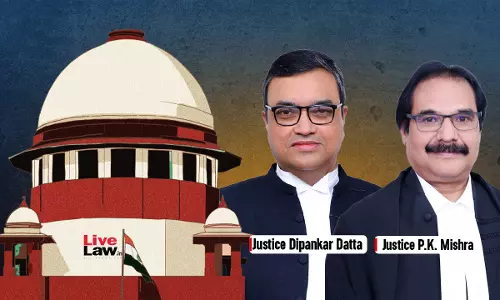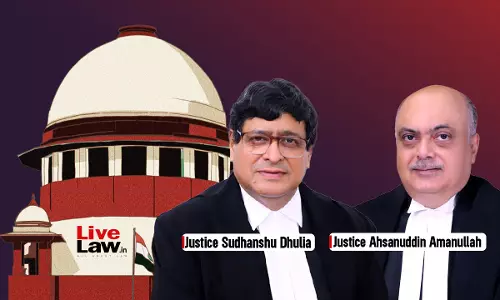'We Cannot Take This 16% Reservation Lightly', Says Supreme Court On Maratha Quota[Hearing Day 8]
![We Cannot Take This 16% Reservation Lightly, Says Supreme Court On Maratha Quota[Hearing Day 8] We Cannot Take This 16% Reservation Lightly, Says Supreme Court On Maratha Quota[Hearing Day 8]](https://www.livelaw.in/h-upload/2021/03/08/1500x900_390235-justices-ashok-bhushan-l-nageswara-rao-hemant-gupta-abdul-nazeer-and-ravindra-bhat.jpg)
On the 8th consecutive day of the hearing in the Maratha quota case, a constitution bench of the Supreme Court posed queries regarding the backwardness of the Maratha community so as to justify 16% quota for them as a Socially and Economically Backward Class(SEBC)."We cannot take this 16% reservation lightly", the bench remarked during the hearing.The bench observed that Marathas...
On the 8th consecutive day of the hearing in the Maratha quota case, a constitution bench of the Supreme Court posed queries regarding the backwardness of the Maratha community so as to justify 16% quota for them as a Socially and Economically Backward Class(SEBC).
"We cannot take this 16% reservation lightly", the bench remarked during the hearing.
The bench observed that Marathas were represented highly in services. It also said that there were reports that Marathas were doing better than other communities.
"Can it be concluded from these stats that Marathas are backward?", the bench sought to know. It also remarked that merely because most members of the community are involved in agriculture activities, it does not mean that they are backward.
The Constitution Bench of the Supreme Court was holding the 8th day of hearing on the petitions challenging the Constitutionality of the Maharashtra State Reservation for Socially and Educationally Backward Classes (SEBC) Act which provides for a quota to Marathas in jobs and education.
A 5- Judge Bench of Justices Ashok Bhushan, L. Nageswara Rao, S. Abdul Nazeer, Hemant Gupta and S. Ravindra Bhat was presiding over the matter. The full account of the hearing is given below :
1. Senior Advocate Shekhar Naphade
Appearing for State of Tamil Nadu, Naphade submitted that the Indra Sawhney judgment had to be reconsidered.
"All judgments after Balaji including Indra Sawhney proceed on the assumption that 50% is the rule and that's a part of the ratio. It is extremely difficult to cull out what's the ratio in the judgement."
He stated that the maximum of 50% stipulated in the 9-Judge Bench judgement was not based on scientific data nor on any established and agreed formula. It was further submitted that Article 15(4) did not place any limitation and the field was open.
"Article 15(4) has a non-obstante clause. The adequacy of representation has some correlation to the population of the backward classes in relation to the total population. The real question is how is this worked out? Observation of Justice Jeevan Reddy supports my view that 50% cannot be the rule".
Naphade argued that the observations in Indra Sawhney that areas had to be "remote and far-flung" in order to form an exception to 50% was a passing remark and not a ratio; it was merely illustrative.
On the issue of Article 324A, Naphade submitted that the list of backward classes decided by the President under Article 324A(1) was only restricted to employment in Central government or institutions run by the Centre. Further, taking away the State's powers would entail tinkering of the federal structure which was protected under Kesavananda Bharati.
2. Senior Advocate Mukul Rohatgi
Rohatgi, appearing for States of Tamil Nadu, Chhattisgarh and Karnataka, referred to Article 371(J) while arguing that 50% should not be the limit.
"If 50% limit is enforced, 371(J) will have to be read into Articles 16 and 15. This is crucial in understanding if 50% is valid or not. It is imperative that these matters are re-examined. 371(J) talks about domicile-based reservation."
In making the aforementioned point, Rohatgi submitted that India was a country with an amalgamation of different laws, rules, identities, procedures, and a 50% limit could not be imposed as it was important to consider the changing aspirations and demographics of the country as a whole.
With respect to Chhattisgarh, it was averred that the State was truly backward because of remoteness and Naxalism, and that 44% was already accorded to the SC/STs. Therefore, there still existed backwardness and poverty in the State.
He also adopted the Attorney-General's submissions that Article 342A only referred to the Central List, and that extending it to the State List would lead to a violation of federalism.
3. Senior Advocate Jaideep Gupta
Gupta, arguing on behalf of State of Kerala, contended that a relook of Indra Sawhney was required as much water had flown under the bridge since 1991.
"When Indra Sawhney was considered, there was an understanding that only historical backwardness was supposed to be rectified. EWS was not considered at that stage. This cannot be seen as a part of 50%. Amendment to the Constitution is not intended to reallocate the existing 50%. It is supposed to be an addition. After the 103rd Amendment, Court needs to consider whether the cap can remain".
On Article 342A, Gupta submitted that powers under this Article were an addition to existing powers and that it was an extreme proposition to state that only the President could specify State reservation.
"This would mean that elected representatives of the State will not have a voice, but the Executive, with the President sitting in Delhi and the Governor, will have full power to deicde who is backward in a State. If there is a conflict, there is a huge price to pay. In a federal structure, with different regimes in the Centre and State, this will become an issue of great political conflict", concluded Gupta.
4. Senior Advocate CU Singh
Appearing for an intervenor who was party to the Bombay High Court proceedings, Singh informed the Court that he wanted to show quantifiable data with respect to the Gaikwad Commission report stating that it was the heart and soul of the exercise which had been made light of by the Petitioners.
It was submitted that the Commission had found Marathas were historically badly represented as well and that being engaged in agriculture and agricultural labour with low means of subsistence was one of the factors considered to gauge their backwardness.
The Court, at this juncture, noted that Marathas were doing better than others and that they were not convinced by the approach in the study.
"How can you select two villages where Marathas are dominating in the village and leave out villages where Marathas are not in the majority, and then compare them. Commission has collected a large number of data, but can you arrive at this conclusion of backwardness from it? That is the question".
It was also observed by the Court that merely because Marathas migrated to slums in cities, they could not be ascertained to be backward, and that being in agriculture and agricultural labour did not indicate that they were backward.
Singh responded, "That is not my argument. I am showing that the Commission took into account a plethora of factors to find that they were SEBCs." He further highlighted that there was a negligible proportion of Marathas in civil services, higher education, engineering and medical colleges.
"OBCs form 32 of the Maharashtra population and their reservation is also around 32%. For them, it's almost a cent per cent reservation to match their population. What is the justification for a class which is much worse than OBCs to not get the same reservation?"
It was further averred by Singh that representation in Mumbai University was abysmally low with 0% Professors and 7% Assistant Professors belonging to Marathas. To this, the Court asked, "Can it be concluded that Marathas are backward? Your argument is that because they are not adequately represented, they are educationally backward?"
Singh submitted that inability of Marathas to reach that level was an indicator of their backwardness and that the overall picture had to be looked at while going through the Commission's report.
Referring to political forwardness, he stated, "Being politically powerful does not mean that the community cannot be socially and educationally backward. Yadavs in Bihar may be politically powerful, but they are still OBCs. One has nothing to do with the other."
5. Senior Advocate Paramjit Patwalia
Patwalia made submissions on the Gaikwad Commission report and stated that it was an advisory document to advise the government on the way forward.
"This has rightly not been challenged in any writ petition except for one by Talekar where his focus is on getting reservations for Muslims. None of the others have raised a challenge."
He further contended that the impugned report calls for a review in 10 years, and is not forever.
"This report being in the nature of an advice is not the subject matter of judicial scrutiny like the Court would scrutinize a judgment. The purport of the report has to be kept in mind."
Senior Advocates Mahalakshmi Pavani, V. Shekhar, Tapesh Kumar Singh, Arvind Verma, along with AG of Meghalaya Amit Kumar and Advocate Sudhanshu S. Choudhary, also made submissions before the Court.
BACKGROUND
The pleas before the Constitution Bench challenges the Bombay High Court judgment passed in June 2019, and submits that the Socially and Educationally Backward Classes (SEBC) Act, 2018, which provides for 12% and 13% quota to the Maratha community in education and jobs respectively, violated the principles laid in the case of Indira Sawhney v. Union of India (1992) as per which the Apex Court capped the reservation limit at 50%.
The Bombay High Court, while upholding the Maratha quota, held that 16% reservation is not justifiable and ruled that reservation should not exceed 12% in employment and 13% in education as recommended by the State Backward Commission.
On September 9, 2020, a three-judge Bench of the Supreme Court referred the cases to a larger Bench to determine the issue whether State Government has the power to declare a class as Socially and Economically Backward after the Constitution (102nd) amendment.




